Disclaimer: You are responsible for acknowledging and following the laws of your state governing the purchase and sale of firearms and firearms accessories. It is your responsibility to be familiar with your own local and state firearm related laws, restrictions and ownership requirements.
Since their creation, people all over the world have been using firearms to defend their property, their homes, their families, and themselves. Fast forward to today: millions of Americans use firearms for self-defense daily, whether they carry one with them every day, or keep them stored in their house; the right to keep and bear arms is guaranteed by the Second Amendment of the Constitution. With firearms being a popular choice for self-defense, Americans have the best tools available for self-protection and self-preservation.
Depending on which state you live in, you may be limited to other defense tools like knives, baseball bats, and less lethal options like tasers, pepper spray, and martial arts. If you live in a state that doesn’t restrict them, firearms are the best tool for self-defense, providing you with the advantage of a firearm against a potential aggressor.
Are you a new gun owner or interested in learning about using firearms for self-defense? Follow along and we’ll break down all the basics you’ll need to know.
Safety Rules:
Regardless of what firearm, or firearms, you go with; it is important to practice good firearm safety. Most firearm accidents occur from negligence and poor firearm safety. Below are key rules based on informal research you need to follow when handling firearms and please remember them anytime you are around firearms:
1. Treat every firearm as if it is loaded—Keep your weapon on safe until you intend to fire.
2. Always keep your muzzle pointed in a safe direction—Regardless of whether it is loaded, keep your muzzle pointed in a safe direction (either downrange, or at the ground) when holding or transporting it.
3. Be sure of your target AND what is beyond it when shooting—Never shoot unless you can clearly identify your target and what is beyond it. If you miss, you risk hitting something behind your target (something or someone else).
4. Keep your finger off the trigger until you are ready to fire—Until you have identified your target, what’s beyond it, and have a clear shot, keep your finger off the trigger. One of the most common causes of a negligent discharge is accidentally pulling the trigger due to surprise or carelessness.
Remember to take your local law into consideration, as they may have additional rules and regulations you’ll need to follow.
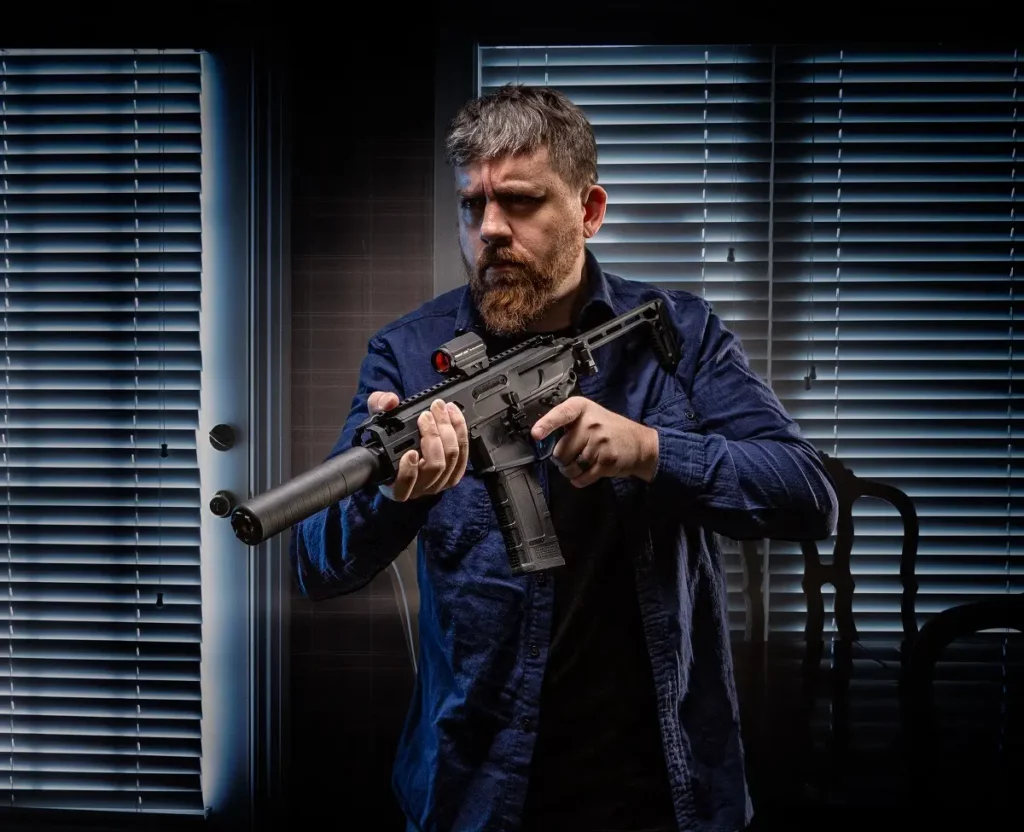
Why Choose a Firearm for Self-Defense?
Firearms are a great tool for self-defense. They can be an effective deterrent to any potential threat that may arise, and when your life is in immediate danger, a firearm can be a life-saving force multiplier.
Using a firearm for self-defense allows you to engage a threat without getting into reach of bladed or blunt weapons; it gives you the ability to focus fire on a target, without being in arms reach of an assailant. In some cases, just presenting a firearm can cause an assailant to flee, though this usually won’t be the case. If the aggressor continues to threaten you, a firearm is a reliable force multiplier that does not rely on muscle or body mass to be effective.
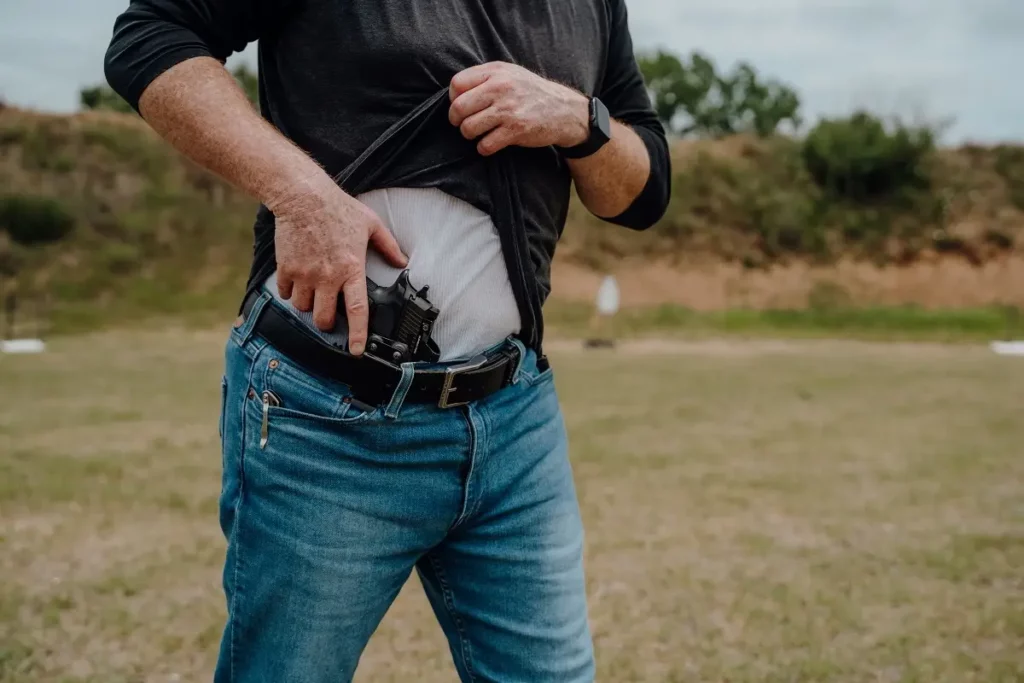
What firearm should I get for defense?
There are many brands, types, and calibers of firearms for sale in the United States. The three most common types of firearms are handguns/pistols, rifles and PCCs, and shotguns.
Handguns/Pistols
Handguns are a great starter firearm for new gun owners and those looking for self-defense options. They generally come in 2 styles: revolvers and semi-automatic pistols. Revolvers feature a revolving cylinder that holds, on average, anywhere from five to seven rounds, depending on its size and caliber. Semi-automatic pistols have removable magazines that can store more ammunition and are also quicker to reload. With that, combined with their ease of use, we recommend using semi-automatic pistols for self-defense, though revolvers can still be used to great effect. Remember that you will only be effective with a handgun if you train properly. Take note if you plan to take the course: the Texas CHL semi-auto qualification course covers semi-auto and revolvers, but not the other way around. No matter which option you go with, the biggest advantage of a handgun is its small size, allowing for concealed and everyday carry.
The trade-off is that pistols are usually the weakest in force delivery, and the compact, hand-held size means recoil is more pronounced. Many new gun owners find pistols to be the hardest to shoot accurately, which is generally true unless you practice regularly and refine your technique. If you would like more information on firearm training, you’re in luck because we have a blog that’s all about it right here.
For pistols, ammo capacity varies depending on the size of handgun you own and whether it uses a single or double-stack magazine. Single stack magazines have one round stack on top of the other in the magazine, while double stack magazines are wider and stagger them side to side, giving it a greater carrying capacity. For example, the Glock 43x features a standard single stack 10-round magazine capacity, while the Glock 19 has a standard double stack 15-round magazine. Some standard capacities you’ll find in semi-automatic handguns are 8-round, 10-round, 15-round, and 17-round, depending on the model handgun.
We’d like to note that pistols can come in much smaller rimfire calibers like .22 long rifle, .17HMR, and .22 magnum. Having significantly less recoil than centerfire calibers, they are easier to shoot but are not recommended for personal defense because of inconsistencies in ammo quality and terminal ballistics. We recommend using a 9mm handgun, or .380ACP if you’re looking for lower recoil. While .380 used to be disregarded due to its inferior ballistics, many modern defensive loads have proven to be quite effective in testing, proving that it isn’t the anemic round once thought.

Rifles and Pistol Caliber Carbines
Rifles are another excellent option for self-defense. Characterized with a 16-inch or longer barrel, rifles are much larger than handguns but still have a good size form-factor allowing for optimal control. Rifles can have barrel lengths shorter than 16 inches, but you must have an NFA tax stamp to make it a legal SBR (short-barreled rifle). With three points of contact instead of two, rifles are much easier to control and allow the user to have larger capacity magazines with superior terminal ballistics. An AR-15, for example, has a standard magazine capacity of 30 rounds, though some states have laws limiting magazine capacity and AR-15 ownership. Also, AR-15 rifles allow for the attachment of a multitude of firearm accessories, like red dot sights, weapon lights, and slings. This allows you to add what you deem fit, customizing the rifle to fit your personal needs.
The versatility of this platform is incredible. If you’d like to learn more and go in-depth on the AR-15 platform, we have a blog where we break down the AR-15 and its features here.
The AR-15 can be chambered in a wide variety of calibers, but the most common is 5.56x45mm/.223 Remington and .300 AAC Blackout. An intermediate rifle cartridge, 5.56 has a much higher velocity than traditional handgun cartridges, but some ammo manufacturers provide “self-defense” ammunition that features an expanding hollow point, minimizing pass through from over-penetration, while maximizing ballistic efficiency. .300 Blackout is a lower pressure cartridge that utilizes a larger .30 caliber projectile. With the lower pressure round, there is less risk of over-penetration when using a hollow point round.
Even though hollow point ammunition greatly reduces pass through, the higher velocities of 5.56/.223 and .300 Blackout ammunition makes it a potential risk; if you go with an AR-15, you will need to pay close attention to your surroundings and be more conscious of your shot placement.
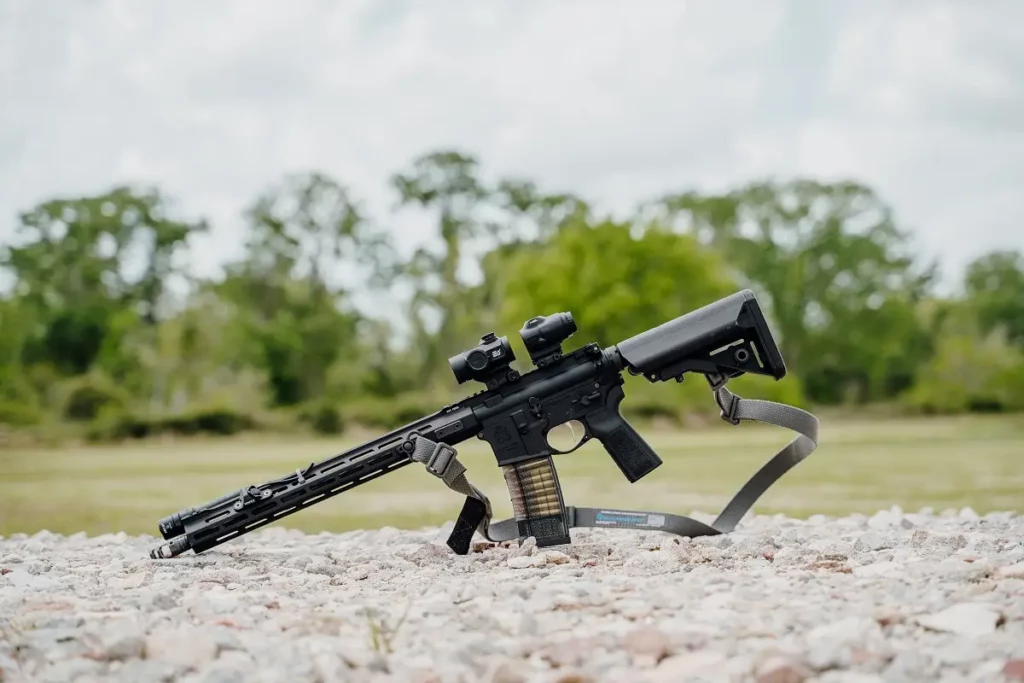
Though 5.56/.223 and .300 Blackout are the most popular cartridges for AR-15 style rifles, they can come in a variety of other calibers. AR-15 platform rifles that are made as PCCs are chambered in pistol calibers like 9mm and .45ACP, giving users the control and versatility of an AR while keeping the low recoil and lower velocity of pistol calibers.
In addition to AR-15 rifles, you could also opt to use a Pistol Caliber Carbine or PCC. A PCC is a rifle that is chambered in a smaller pistol caliber. Firearms like the CZ Scorpion, Sig Sauer MPX, and AR-9 rifles are all PCCs that are great for home defense.
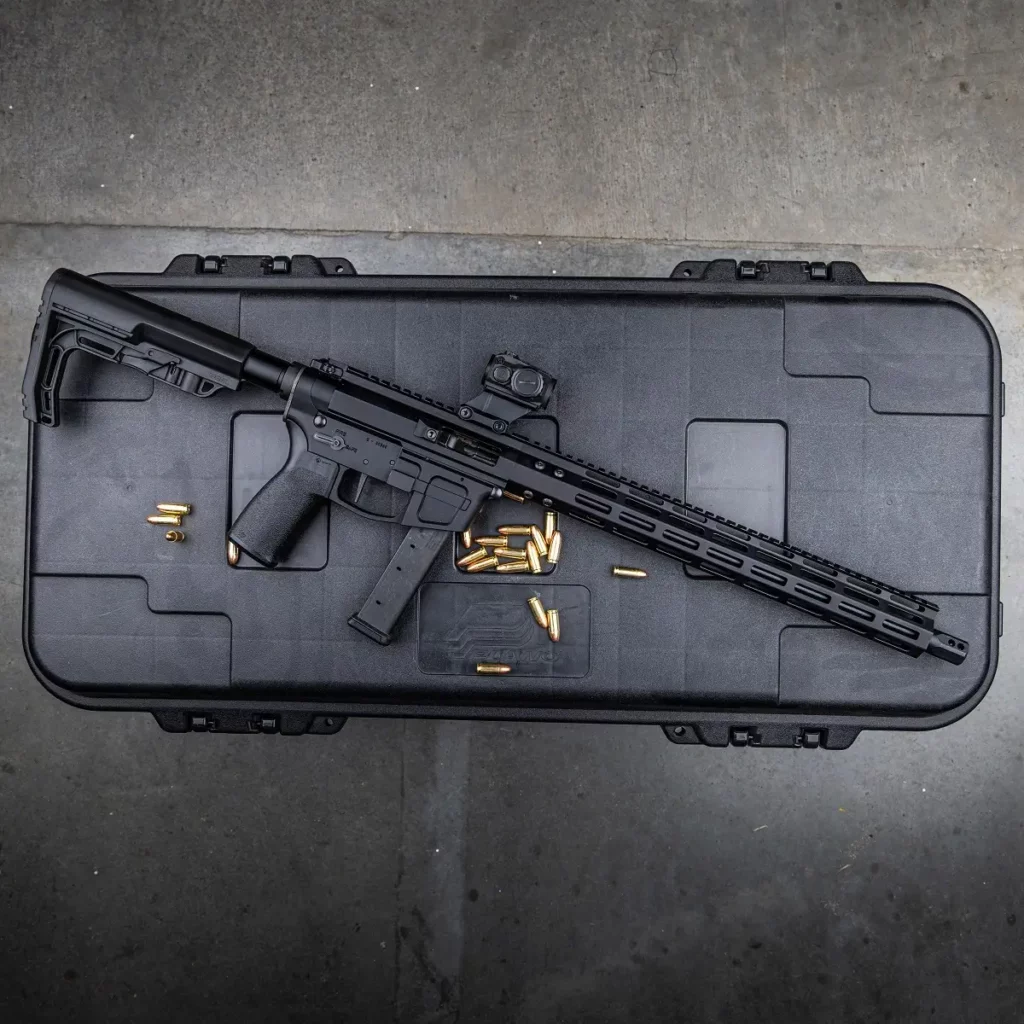
Shotguns
Shotguns are another common type of firearm used for self-defense. Shotguns usually have a smooth bore with some special models having a rifled bore, and a minimum 18-inch barrel. Like rifles, you can have shotguns with barrel lengths less than 18 inches so long as you have an NFA tax stamp for it to make it a legal SBS (short-barreled shotgun). Unlike rifles and pistols, shotguns don’t use traditional cartridge ammunition and instead use shotgun shells. These shells are much larger than handgun and rifle ammunition, and they come in a variety of different shot types.
One of the most common shotguns in America is the Remington 870. It is a standard pump-action shotgun chambered in 12 gauge, though they can also come chambered in 20 gauge, and .410. Contrary to traditional calibers, where larger numbers typically indicate a larger round, shotgun shells are bigger when the gauge is smaller. Therefore, 12 gauge is larger than 20 gauge, and so on.
The smooth-bore design of shotguns allows them to be compatible with a wide variety of shot types, with the most common for home-defense being 00 buckshot. Buckshot differs from traditional center fire calibers in that one shell of buckshot can fire 8-9 pellets, when a normal centerfire round only has one projectile.
This gives shotguns a wider point of impact, or pattern, that handguns and rifles don’t have. Side note: some shells come with a single slug instead of multiple projectiles; it minimizes spread, but with their increased mass and velocity, over-penetration is very common. In a defensive scenario, buckshot provides good penetration on target while also having a lower risk of over penetration.
However, shotguns aren’t without their drawbacks. By federal law, a shotgun must have at least an 18” barrel, unless you have an NFA tax stamp. Shotguns also have smaller ammo capacities, are trickier to reload, and have much higher recoil. Pump-action shotguns also require the user to operate the pump between each shot, which requires training for full effectiveness.
On one last note, pump action shotguns make a distinct noise when chambering a shell. It may alert the intruder to your presence and position or cause them to escalate an attack; at the same time, the sound could also be a deterrent to an assailant.
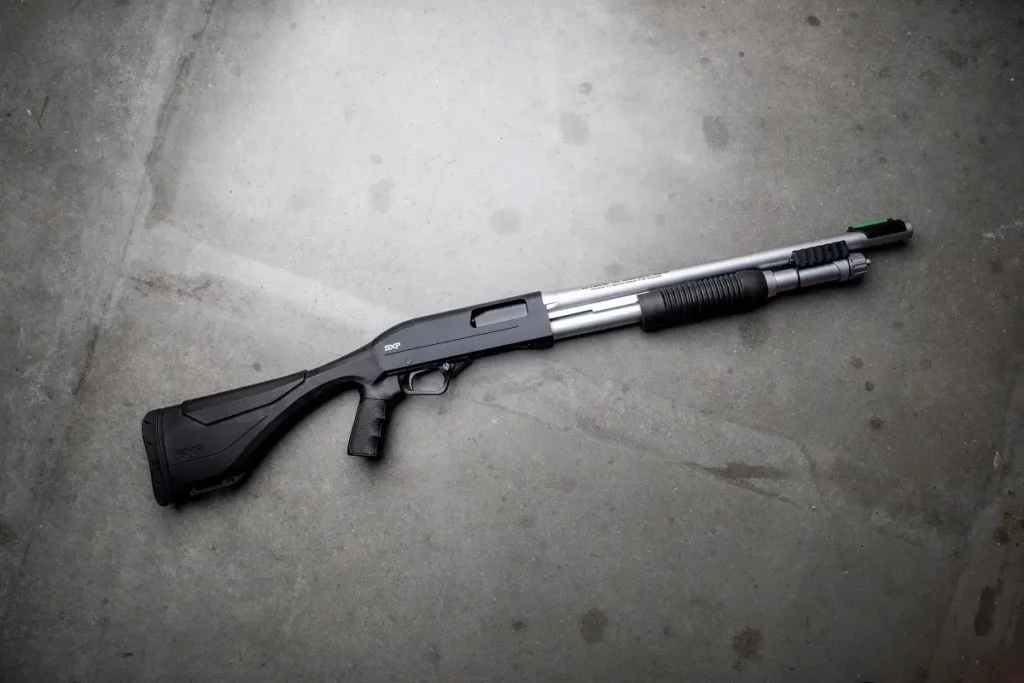
So which gun should you use?
Your needs and surroundings will dictate what firearm is best for you. For concealed carry and personal defense outside the home, unless you live in an open carry state, a pistol is your only option. While AR-15s and shotguns are certainly more potent than pistols, it isn’t practical to carry one with you everywhere you go, making them a better option for home defense.
Ultimately, it is up to you to decide what works best for your needs, so it’s important to conduct research about the firearms you want. Researching manufacturer websites and talking with experts at your local gun store is an awesome way to get educated on different firearms. Also, if possible, go to your local gun range and shoot rental guns if they have a rental selection available.
Chances are, they already have the same model you want, or one similar, available for rental in the range. Test-firing range rentals are the best way to narrow down what you like and don’t like since you can see how they shoot rather than just how they feel in your hand.
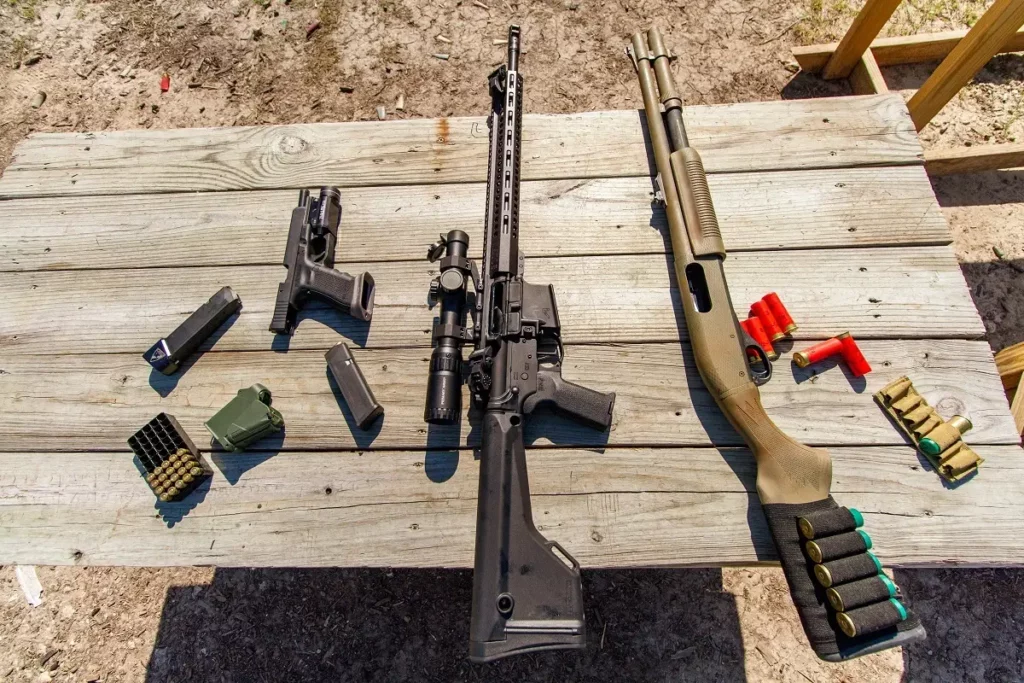
Gun Safety and Its Importance
Storing your firearm:
In addition to following the firearm safety rules, you will need to think of where you want to store your firearm. Your firearm needs to be in a secure location such as a safe with a combination lock and heavy-duty steel locking systems. Safes are one of the best places to store your guns long term. However great safes are, they aren’t always an option for everyone.
Fortunately, lockable gun cases exist with some firearms coming with them as a standard option. These cases can be stored in closets or under the bed, secured by a lock and key, keeping anyone but the owner from having access to it. This is a great solution if you live with family or roommates but don’t have the money or space for a full size safe. If you have children, you are responsible for keeping your firearms in a secure location. You can find these responsibilities outlined by the ATF in the Youth Handgun Safety Act here.
Ideally, you want to store your firearm in a secure but accessible location. In the event of a home invasion, having quick access to your firearm is ideal. You could store it in a bedroom drawer, under your bed, or keep it tucked away in a bedroom closet. Just be mindful of its proximity to your bathroom, as repeated exposure to steam from a hot shower can cause steel to rust.
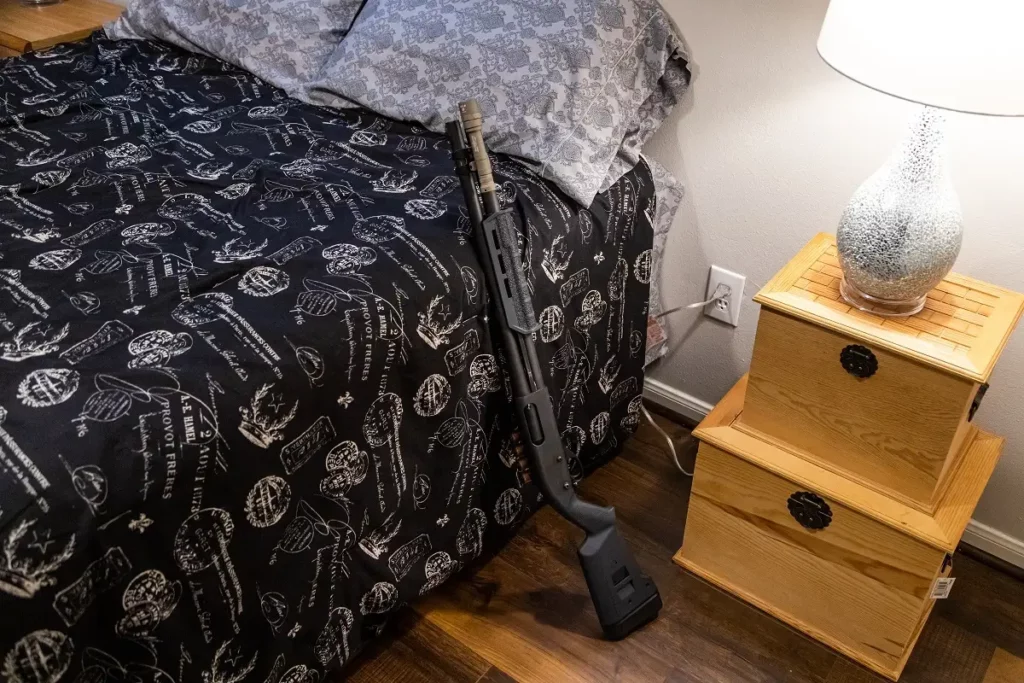
Purchasing a firearm for defense:
Purchasing a firearm, while subject to restrictions, can be done online or in person at a gun store. Especially for the first time, purchasing a firearm can be a confusing process. Trust us, it really isn’t when you get started.
Before you go to buy your firearm, make sure that you are old enough to purchase the firearm you want, and bring a photo I.D. (driver’s license). You also want to check your local and state laws to see if there is any additional paperwork or permits required to buy/own a firearm. For example, in some states, residents are required to have a pistol purchase permit before they are eligible to buy a handgun. Laws will vary from state to state, so be sure to check before you go out to make a purchase.
Purchasing a gun online is simple. Select an FFL (Federal Firearm Licensed Dealer) near you to send the firearm to, like a local gun store or pawn shop. Be sure to notify them to see if they will conduct a firearm transfer and background check for you. While most will do so for a fee, not all FFLs will accept transfers from other vendors. With your FFL selected, you can add the firearm of your choice to your cart and check out like you normally would online. The only difference in the checkout process is that you need to ship the order to the FFL that you selected and email a copy of your invoice along with the FFL information to ffl@primaryarms.com. Be sure to let your selected FFL know what firearm you bought so they look out for its arrival.
By now, you’ve decided what firearm you want to use for personal defense, purchased it, and sent it to your FFL. Now you get to start the process needed to make it yours and take it home. While the process varies from state to state, no matter where you live it involves selecting the firearm you want and filling out a Form 4473. A Form 4473 is the form you will fill out to start your background check process. If you are buying a firearm from an FFL (Federal Firearm Licensed Dealer), you must complete a Form 4473. After you’ve filled out the form, the salesperson at the store will take the info on the form and from your I.D. to run your background check with the FBI’s NICS system. Keep in mind that some states may have a mandatory waiting period or other special requirements before being eligible to buy a firearm. You are responsible for knowing your state’s laws.
After they have completed your background check, you will either receive a “proceed”, “delay”, or a “deny” result.
Getting a “proceed” means you’ve passed your background check and are all clear to purchase your firearm or pay the transfer fee if you ordered online, barring additional state or local requirements.
A “delay” means your background check is taking longer than normal, and you can’t purchase your firearm yet. This doesn’t mean that you won’t be able to buy a firearm period, it just means you must wait longer for the result.
A “deny” means you cannot purchase a firearm. Denies occur when the purchaser fails the background check or has a state or federal prohibition keeping them from being able to purchase a firearm. If you do receive a denial, you have the right to appeal their denial.
If you receive a ‘proceed’ and fulfill all other applicable state/local requirements, you can pay for your firearm or transfer fee and take it home with you. Welcome to gun ownership! If you haven’t already, plan on buying some extra ammunition for your new firearm. We recommend getting a box or two of the self-defense ammo of your choice (JHP for pistol), and then a few boxes of standard target ammunition. Self-defense ammo usually costs more than standard target ammo, so you definitely don’t want to be shooting that at the range for target practice.
Training
Congratulations! You are now a gun owner. But just owning a firearm does not make you proficient when using one. Training is a must if you want to effectively use your gun for defense. We’re going to break down a few simple ways you can practice defensive tactics both at home and at the shooting range.
Dry-fire Exercise
Dry-firing consists of clearing your firearm and pulling the trigger to get a feel for how your firearm operates. To practice this, start by clearing the firearm by dropping the magazine from it, and pulling the slide or charging handle back to check the chamber. Once you have visibly confirmed that there is not a round in the chamber, your trigger is primed and ready to be used, though there is no ammo in the firearm.
Now you can practice by acquiring a target and pulling the trigger. Find a “target” to practice dry firing at. You can use a target taped to your wall, a specific point on a drawer, or a coat rack; anything that you can clearly and safely dry-fire at can be a suitable target. Before you begin, remember the firearm safety rules we covered before.
Start in the low ready position, present your firearm and line up your sights with your target, and pull the trigger. You’ll hear the click, meaning you can charge your firearm again and repeat the process. You’ll want to focus on holding the sights steady and staying on target while smoothly pulling the trigger. If you use snap caps or dummy rounds when dry-firing, your firearm will be a similar weight to how it feels when loaded. Additionally, laser cartridges exist to show where your shot placement is when dryfiring; this is extremely helpful when practicing. If you want an added challenge (when dry-firing with a pistol), balance a coin on the end of your pistol and pull the trigger. If the coin falls, you are likely jerking the trigger or flinching. Try pulling the trigger again so that the coin doesn’t move. Increasing your repetitions with proper form will get you more comfortable with handling your firearm, and continuing this process multiple times a week will serve to improve your muscle memory and overall firearm handling skills.
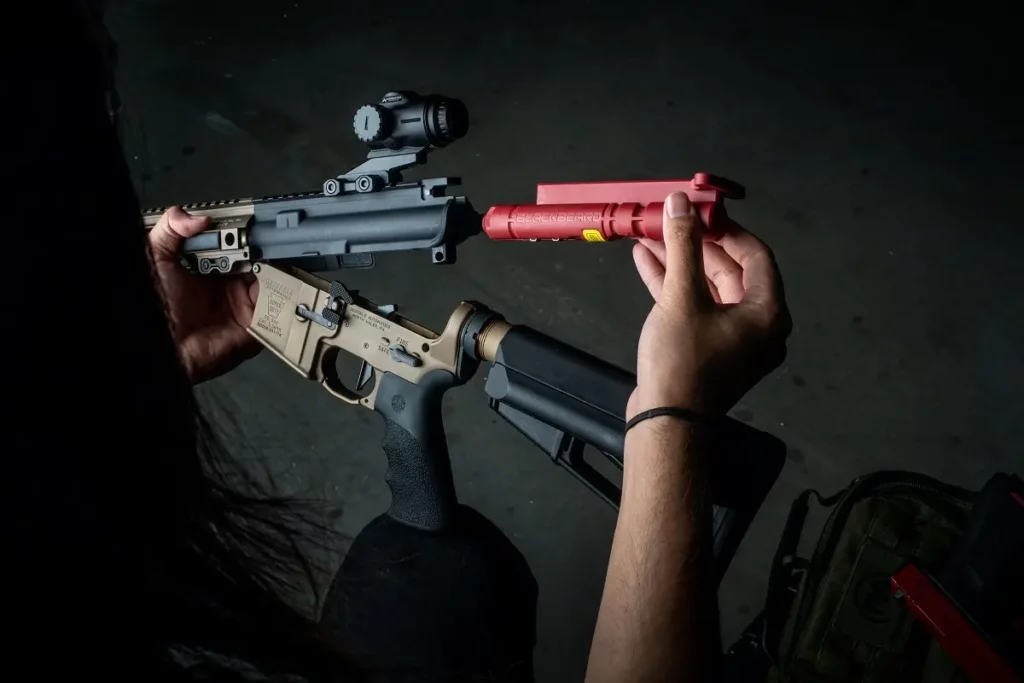
Range Practice
While dry-fire is a good way to practice firearm handling within your home, target practice is the best way to practice all fundamentals. Go to your local shooting range, set up a target, and practice shooting from different ranges. At an outdoor range, there will be different distances to set up targets at; at an indoor range, the targets can be adjusted using a slider machine. Start close from 5 to 10 yards and fire at the target, noting your shot placement and groupings. If your groups are wide and scattered, you are likely flinching, gripping the gun too tight, or not gripping the gun tight enough. Readjust and fire again; once your groupings improve, you can set the target out at farther distances and practice from there.
New gun owners will often make mistakes when shooting and it’s important to correct them early on, so they don’t become a reinforced bad habit. Make sure you have a good grip and stance. If you’re shooting a pistol, your grip should be firm with support hand wrapped around the firing hand. For rifles and shotguns, tuck the butt of the stock in your shoulder, keeping a firm grip on the firearm with your firing and support hands. Keep your feet shoulder width apart, staggered with one foot in front of the other like a boxing stance. Lean into your rifle, or slightly forward if using a pistol, when shooting, keeping your weight forward to absorb the recoil. This will keep you from getting knocked around by the recoil when shooting.
Keeping your sights aligned is a must. Many new firearm owners grip their firearms too tightly in anticipation of the recoil. Instead of this, loosen your grip slightly and pull the slack out of the trigger, once you’ve hit the wall of the trigger, readjust your sights and pull the trigger through. Practice this method in reps and you’ll develop the necessary muscle memory for later.
Becoming a better shot takes time and practice. You won’t be a pro immediately, but by taking the time to practice your fundamentals, you’ll be more than proficient in no time. Remember this: the more you practice firearm training, the more ready you will be for any type of self-defense situation. A great way to gain experience when shooting is by taking classes. If you’re interested in taking a carbine course, find out more about them here.
You will need training and proper firearm knowledge before doing so, but training in carbine courses, defensive pistol courses, and three-gun matches can test your abilities and sharpen your skills. While it isn’t necessary to take courses to become better at using a firearm, it can greatly improve your ability quicker.
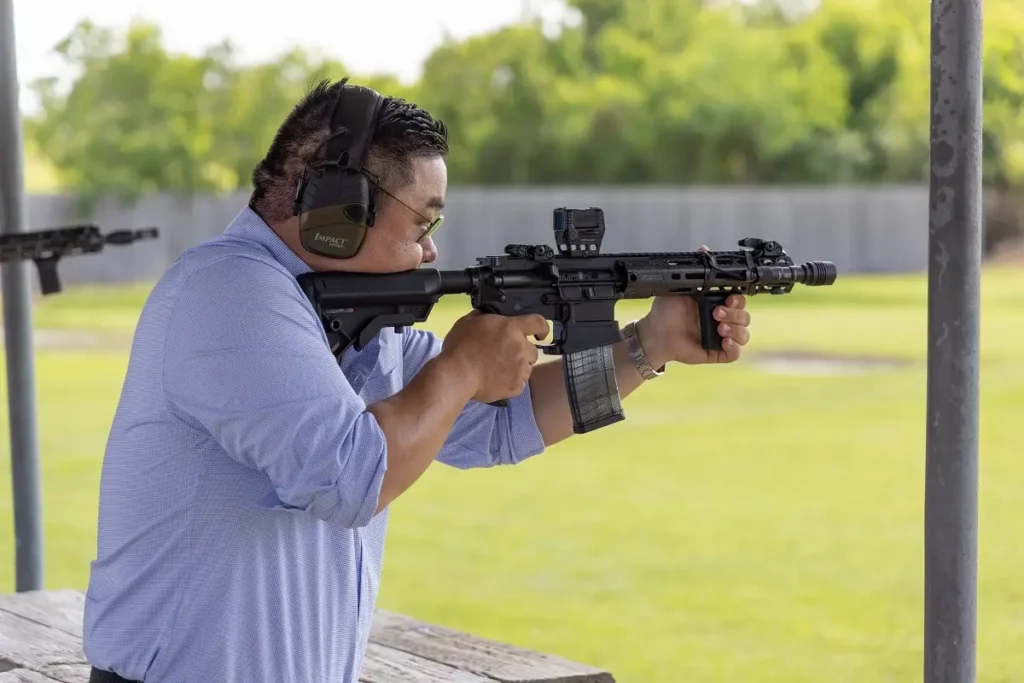
Conclusion
With self-defense, the goal is to be as prepared as possible for any scenario. Though there are many firearms available, considering your surroundings and whether you want to conceal carry will help narrow down your options. Remember to practice whenever you have the chance and remember to always be safe and responsible with the storage, training, and use and application of your firearm; you will never regret becoming more comfortable with your firearm.
Last, never stop learning. Talk to your local range and sign up for classes to learn directly from trained professionals. Watch videos online, like this one from the NRA about tips for new pistol shooters, to learn more about niche topics and continue to read blogs like this one to stay up to date on new products and practices that can benefit you later.
Shooting takes a few minutes to learn, but a lifetime to master. Keep training and never stop learning.



